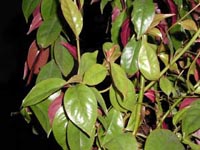Resource Library
Plant of the Week: Pereskia
The University of Arkansas System Division of Agriculture does not promote, support or recommend plants featured in "Plant of the Week." Please consult your local Extension office for plants suitable for your region.
Plant of the Week
Pereskia
Latin: Pereskia

Dogma is comfort food for the soul. In our ever more complicated world, we often seek solace by narrowing our view, not expanding it.
But, the world is a complex place with all sorts of interconnected strands making up the web of life. Sometimes, as in the case of Pereskia - a leafy cactus - reality collides with facts we know and understand.
Everyone knows that cacti are bizarre, thorny, leafless plants adapted to dry places. But, Pereskia never got the memo, so it kept its leaves while the rest of the cactus tribe moved on to become the more familiar denizens of the deserts.
Of the 20,000 species of cacti that have been described, only about 20 have true leaves. Pereskia grandiflora, the wax rose, is native to Brazil and one of the most commonly grown. It’s a deciduous, multi-branched shrub with rose to white, cactus-like flowers to an inch and a half across.
Pereskia leaves are entire, glossy-green and sometimes purple-tinged. Unlike most cacti, the stems are not segmented, but the stems are armed with the same kinds of thorns found in other cacti, all produced in a structure called an areole. The fruit is a yellow, pear-shaped structure typical of all cacti.
Not only are leafy cacti an enigma, but their very existence cries out for an explanation of how they fit into the cactus family. Pereskias are considered the ancestors of all cacti, but discerning their evolutionary path is a bit tricky. Because they grow in desert terrain, fossil records never form. Cacti occur in only the New World, but DNA data and the kinds of pigments founds in their flowers, suggests their distant relatives are African. How can this be?
The answer lies in the theory of continental drift, another affront to some belief systems. Geophysicists call it a "theory" because a few details are yet to be worked out, but in the last 40 years it has become universally accepted amongst earth scientists. Continental movement on 10 large, independently moving plates is the best way of explaining the observations that have puzzled geologists, geographers, and all kinds of biologists for the past several centuries.
By using space-based instrumentation, this drift can be observed. Most continents move in a generally westward direction, dashing along at from one half inch to four inches a year. Continental drift was first proposed by Alfred Wegener (1880-1930), a German geophysicist who used rock samples from Africa and South America to show that the two continents had once been joined together as a single land mass. A glance at a world map will show how the two continents fit together like pieces of a puzzle.
According to the best estimates, South America and Africa parted ways about 135 million years ago. But the first cacti did not appear right away, probably evolving sometime between the extinction of the dinosaurs and 30 million years ago. Cacti migrated to North America during one of the two continental collisions that occurred in the last 30 million years. The most recent collision occurred just two million years ago when the Central American chain was formed.
I’ve always liked cacti because they remind me of a boy I once knew who was always getting into fights. His reasoning was: "When you’re ugly, you gotta’ be tough."
Pereskias are not especially common houseplants, but you can find them sold on the Internet. When fully bedecked in leaves, they’re handsome bushes. Only during their deciduous phase does their ugliness and relationship to the rest of the cactus tribe really stand out. Young plants and green stems are not particularly thorny, but woody stems are better armed.
They make a good, tough houseplant as long as you have a bright wintertime home for them. If you don’t, they will still survive - after all they are cacti - but they may defoliate. This period of dormancy seems to be required to get the plants to bloom.
When warm weather arrives, trim them back and move the pot outside for a full measure of sunlight
By: Gerald Klingaman, retired
Extension Horticulturist - Ornamentals
Extension News - March 11, 2005
The University of Arkansas System Division of Agriculture does not maintain lists of retail outlets where these plants can be purchased. Please check your local nursery or other retail outlets to ask about the availability of these plants for your growing area.